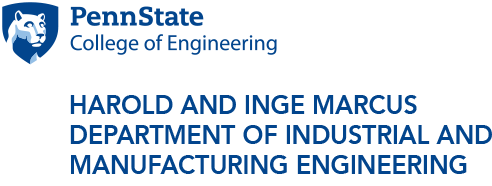
John Samuels presents a 1927 blueprint of Frederick Taylor’s original diagram of the "Shop Management Organization Chart" to Department Head Janis Terpenny. Taylor drew the print for a new steel company in Bethlehem, Pennsylvania, named Bethlehem Steel, at the time.
Alumnus turns job with struggling railroad into vibrant career
11/16/2017
UNIVERSITY PARK, Pa. — During the course of his 50-plus-year career, Penn State alumnus John Samuels (’68 M.S., ’72 Ph.D.) only missed two days of work due to sickness.
A native of Yardley, Pennsylvania, Samuels completed his undergraduate education at General Motors Institute, now Kettering University. There he split his time between working as an engineer for General Motors (GM) and studying engineering at the institution.
“GM [Institute] had a co-op engineering program, so I would go to school for 6 weeks at the institute in Flint, Michigan, and then I would work 6 weeks at a sponsoring plant. My plant was in Trenton, New Jersey,” Samuels said.
Samuels graduated from General Motors Institute in 1966 with his degree in engineering. Following his graduation, he spent the summer working for GM as an engineer.
Shortly after, Samuels notified the company that he would like to take a leave of absence in order to pursue his master’s degree in engineering.
When deciding where to complete his master’s program, Samuels went to Penn State to visit and learn about the industrial engineering (IE) program. While visiting, he met Ben Niebel, the department head at the time.
Niebel offered Samuels a graduate assistantship on the spot during his tour. After that, he said, the choice of which school to attend was obvious.
Samuels began his career at Penn State as a master’s student and graduate research assistant in now-named Harold and Inge Marcus Department of Industrial and Manufacturing Engineering that fall. He planned to get his degree and then go back to GM to continue his career as an engineer there. At that time Niebel approached him with the then-dean of the college of engineering, Nunzio Palladino, in tow and offered Samuels an instructorship with the department.
“They told me that if I would stay at Penn State, they would make me an instructor and provide the funding for me to get my Ph.D., which would allow me to teach and to continue doing research at the same time,” Samuels said.
And so, Samuels decided to stay with Penn State to continue his graduate career as a Ph.D. student and a full-time instructor. He graduated from Penn State in 1972 with his doctoral degree in IE.
Upon his graduation, Palladino once again approached Samuels and asked him to stay at Penn State as an assistant professor.
“He said, ‘Here’s the deal. If you stay, I’ll personally put you up for tenure in three years,’” Samuels recalls.
Samuels remained on the faculty at Penn State as an assistant professor. After three years the dean came through with his promise, granting him tenure and making him an associate professor in 1975, where he remained for the next three years.
That’s when everything changed for Samuels.
During his time as an associate professor, Samuels’ work was part-time teaching and part-time researching. He spent most of his time researching in the railroad industry. It was in this way that he began to work with Conrail. He spent his consulting hours working to design a plant for the company in Altoona, Pennsylvania. This was an $18 million construction job.
Conrail accepted the design that Samuels presented to them and build the plant, which still exists today.
After that successful project, Samuels said that management at Conrail approached him about leaving Penn State to join them full time. At the time, Conrail was a struggling railroad trying to find a way to stay in business.
“They said, ‘Leave Penn State and be our chief industrial engineer. Your job is to help turn the railroad around and make it profitable,’” Samuels said.
So in 1978, Samuels left the safety of his tenured professorship to work for a fledging railroad. Many thought he was crazy, but Samuels felt like the potential of the opportunity was too good to pass up.
“I was 35 years old, you do crazy things when you’re 35,” Samuels said. “It was a little bit heartbreaking to leave Penn State but it was what I wanted to do. I wanted to manage engineers, and that was one of the major reasons I went back into the industry.”
Once at Conrail full time, Samuels’ career took off and began moving fast. He became the company’s director of IE and put together a 100-person IE department. From there, he got to work on turning the company around.
“In the years between 1978 and 1987, Conrail went from losing $1 million a day to making $1 million dollars a day,” Samuels explained.
Much of this had to do with the work that Samuels and his team did. By optimizing the railroad’s production procedures, Samuels was able to decrease their spending and increase their revenue.
“I climbed the ladder at Conrail and eventually be came the vice president of continuous quality improvement,” he said.
Samuels was quickly promoted again, this time to vice president of engineering for the company. In this role, he said his IE expertise and problem-solving abilities were a huge asset.
In 1996 Conrail was the subject of a hostile takeover by Norfolk Southern Railroad and CSX. In the end, the company was split in half and absorbed by the two railways. Samuels explained that in the process of this takeover, he received job offers from both companies.
“I decided I would stay with railroads for the last 10 years of my career, so I took the job as senior vice president of operations planning and support with Norfolk Southern,” Samuels said.
Samuels stayed with Norfolk Southern for the remainder of his career. In 2006, he made plans to retire, but the company asked him to stay on. He remained as an advisor from 2006-2010, at which time he also ran research for the North American Rail Industry.
When asked about his career, Samuels said that some of his best decisions came from taking a small leap of faith.
Part of his success has to do with the passion Samuels had for his work.
“I worked long hours and it all paid off,” he said. “Every morning I got up and was raring to go. There wasn’t a day that I worked that I wasn’t excited to go to work.”
It was this passion that translated into a long list of career and academic achievements for Samuels. Perhaps most noteworthy is his membership in the National Academy of Engineering (NAE).
Election into the NAE is one of the highest honors in engineering. Samuels was elected and inducted into the NAE in 1996 in recognition of his work in turning around the profitability of the railroad.
Now, in his retirement, he has chosen to do pro bono work for the NAE and the railroad industry. He says he has shifted his focus from working for profit to giving back to the organizations that have given him so much.
“The three things that I have really given back to are Penn State, Kettering University and the NAE,” Samuels said. “My wife and I have established a trustee scholarship at Penn State as well as at Kettering, and we contribute to fundraising for the NAE as often as possible.”
Samuels is incredibly grateful to Penn State and the College of Engineering for the success in his career. Just this past October, he returned to Penn State for one of the many colloquiums hosted by the Marcus department. In addition to speaking to the students about his career on the railroad, he also donated a very special blueprint to the department.
“Frederick W. Taylor was the father of the ‘Industrial Engineering Motion and Time Study.’ He practiced IE from the 1880s to the 1930’, at the beginning of the industrial revolution in the United States,” Samuels explained. “The print is a 1927 blueprint of Taylor’s original diagram of the ‘Shop Management Organization Chart' that he drew for a new steel company in Bethlehem, Pennsylvania, named Bethlehem Steel.”
Samuels brought the Frederick W. Taylor blueprint with him during his visit, and he presented it to Janis Terpenny, the Peter and Angela Del Pazzo Deparment Head of the Marcus department at the beginning of his presentation.
Because there were no copiers, blueprints were one of the only ways to make copies of larger organization charts during the time the Taylor blueprint was made. Therefore, this is a very important piece of engineering history and a generous gift from Samuels.
There’s no question that Samuels had a full and successful career. He says that one of the best decisions he made throughout his career was to always listen for when opportunity would knock.
“One of the things I’ve always told students that are just starting off in the industry is that in your career, there are going to be occasions when opportunity will knock. When opportunity knocks and you don’t answer the door, you are never going to know what you could be missing,” Samuels said. “Keep an eye out for opportunity, it comes in strange ways.”
Because Samuels chose to answer the door each time opportunity knocked, he had a full and long career in both academics and the railroad industry.
“Go above and beyond the academics in life and figure out what you want to do and take some risks,” Samuels said. “Almost all of us have the potential to be a leader, but very few choose to be one. Not for lack of opportunity. Many just choose not to answer the door when opportunity knocks.”



